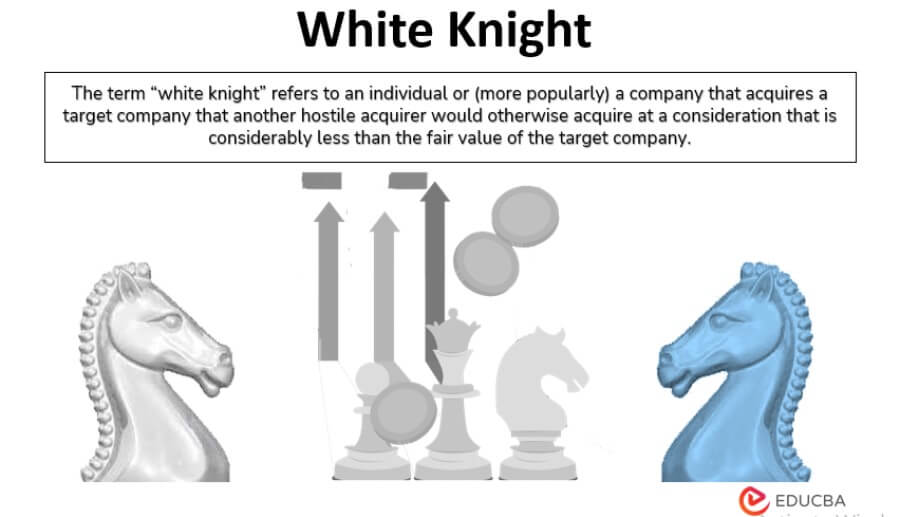
What is White Knight?
The term “white knight” refers to an individual or (more popularly) a company that acquires a target company that another hostile acquirer would otherwise acquire at a consideration that is considerably less than the fair value of the target company.
Interestingly, the company that intends to purchase the target company forcibly is known as the “black knight.” In other words, a white knight takeover comes as a relief to the target company in case of a hostile takeover by a black knight, given that it usually comes up with a much better value proposition that includes retention of the current management team, better terms of the acquisition, etc.
Explanation
On the battlefield, it appears as the savior and the last resort to save its army from the hostilities and atrocities of the opponent. Now, metaphorically business is analogous to a battle, while the marketplace denotes a battlefield. In business parlance, a white knight represents a savior in the form of a friendly acquirer. When a company turns into a target for a hostile takeover, then it comes into the picture with a fair acquisition plan that can save the target company from the hostile takeover and help it grow in the future.
This can be a company or an individual who intends to bail out the target company from a hostile takeover by another acquirer (also called the black knight). Although the target company loses its independence after being acquired by the white knight, it is still far better than being taken over by a black knight.
Examples of White Knight
There are several examples of white knight instances, and some of them are mentioned below:
- Bass Brothers: In 1984, Sid Bass and his sons increased their stake in Walt Disney Productions from 5.5% to 8.6% to become the largest single bloc shareholder of the company and then saved it from the hostile acquisition bid of Saul P. Steinberg.
- Wolters Samson: In the year 1987, Elsevier, which was the largest publishing house in the Netherlands then, expressed its interest in purchasing a stake in Kluwer Publishers in a hostile bid. However, Kluwer Publishers fended off the attempted hostile takeover by Elsevier by merging with Wolters Samson to form Wolters Kluwer.
- Compaq: In 1998, Compaq came to the rescue of Digital Equipment Corporation, which was in pretty bad shape then. Compaq acquired Digital Equipment Corporation for $9.6 billion, partly paid in cash and in exchange for Compaq’s shares. Compaq acted as the white knight for Digital Equipment Corporation’s tottering business in this case.
- Severstal: In the year 2006, Severstal, a Russian steel giant then, acted as the white knight for Arcelor to defend it against Mittal Steel’s merger deal. Severstal offered to pay a higher acquisition price than Mittal Steel, which contributed to paying $34 billion for a 49.4% stake in the merged entity (Arcelor-Mittal).
- Bayer: In 2006, Bayer offered $20 billion to beat the hostile takeover of Schering by Merck, valued at $17.9 billion. Bayer acted as a white knight to save Schering from the hostile merger negotiations with Merck.
- Nissin Foods: In the year 2007, Nissin Foods came to the rescue of Myojo Foods to fend off US hedge fund Steel Partners’ hostile offer of ¥29 billion by offering a higher purchase consideration of ¥37 billion to buy the firm.
- P. Morgan Chase: In 2008, J.P. Morgan Chase acted as the white knight by acquiring Bear Stearns to help it avoid insolvency after its stock price nosedived, resulting in market capitalization declining by 92%. J.P. Morgan Chase purchased at a considerable discount for a mere $2 per share.
- Fiat S.p.A: In 2009, Fiat S.p.A. acquired a 35% stake in Chrysler to save the beleaguered automaker from the jaws of liquidation. The two entities combined to form a new Fiat Chrysler Automobiles.
White Knight in a Hostile Takeover
Now, let us discuss in more detail how a white knight plays its role in a hostile takeover. As we have already discussed that a black knight is a company that intends to acquire the target company forcibly, while the white knight is the friendly acquirer.
Now, the relationship between a white knight, a black knight, and the target company can be elaborated as follows:
- Step 1: Let us assume that Company A (black knight) has expressed interest in acquiring Company B (target company) with a bid offer.
- Step 2: Next, Company B is not satisfied with either the purchase consideration or terms of the deal and rejects the bid offer.
- Step 3: Next, once the bid-offer is rejected, Company A resorts to a more hostile approach and attempts to the takeover of Company B’s stake forcibly, such as purchasing majority shares from the open market.
- Step 4: Next, Company C (white knight) realizes that Company B is under the pressure of a hostile takeover by Company A.
- Step 5: Finally, Company C comes to the rescue of Company B by offering either higher purchase consideration or a better deal term, such as a promise to retain the current management team. In this way, Company C acts as the white knight for Company B by saving it from the hostile takeover attempt by Company A.
Conclusion
So, in this article, we have discussed the definition and how it works, along with some real-life examples to enable you to internalize the concept of a white knight merger. So, by now, you have a good idea about the importance of the white knight in the business scenario.
Recommended Articles
This is a guide to White Knight. Here we discuss an introduction to White Knight, an explanation, and examples with steps to use in a hostile takeover. You can also go through our other related articles to learn more –

